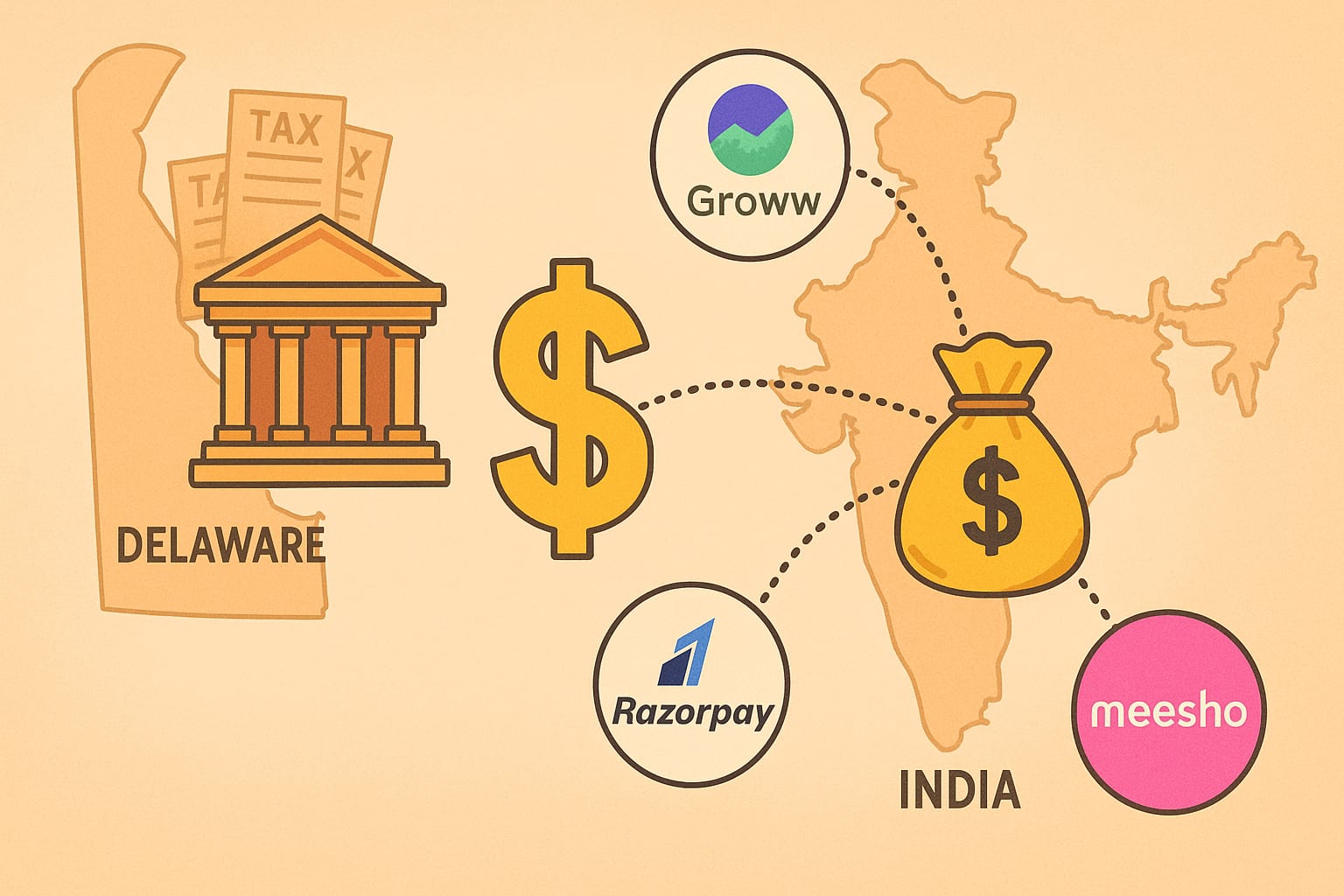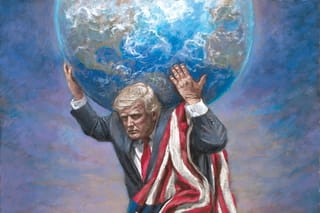
Propaganda images by Trump supporter Jon McNaughton
Fascism starts with talk, not tanks. With democratic elections, not a coup. And it takes hold thanks to people who think things won’t move quickly—until they do just that.
On February 18, 2025, a video appeared on X. An officer from Enforcement and Removal Operations can be seen patting someone down before their deportation flight. The sky over the Seattle airport is overcast. Jet engines can be heard idling in the background.
Then: the clinking of chains. A blue plastic crate, filled with metal restraints. Someone lays them out on the tarmac—one set of cuffs per person. People are cuffed tightly, hands and feet. The camera shows no faces, only bodies and steel. The video ends with a shackled prisoner climbing the boarding stairs with difficulty, his restraints tapping against the metal steps.
The title of the post: “ASMR: Illegal Alien Deportation Flight 🔊”. The abbreviation is a jarring reference to the type of YouTube video that soothes and relaxes the viewer with gentle sounds. Distant whispers, the rhythmic patter of raindrops, the rustling of leaves in the wind. And in this case, the sound of heavily chained men being deported.
Posted by: the White House.*
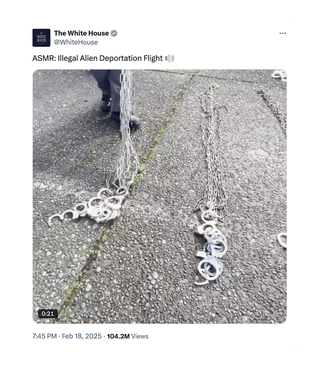

Fascism is back. This time no swastikas, Nazi flags, or deadly bureaucracy, but MAGA hats, right-wing extremist memes, and a triumphant fist held high. No ghettos or concentration camps, but data-driven manhunts and “detention facilities” in El Salvador and Guantanamo Bay. No SS officers or brownshirts, but Proud Boys and a Capitol mob.
It’s perfectly clear: the US president, Donald Trump, is putting together a fascist regime. And fast. Not only Trump’s political adversaries say so, his own former advisers do, too. But what’s more, internationally renowned scholars—the indisputable experts when it comes to fascism—are now sounding the alarm.
Their warnings still evoke resistance. For many, the label “fascism” is inextricably tied to the Holocaust and should be left in the past out of respect for the six million murdered Jews. Others consider the term excessively alarmist: every fascist so far pales in comparison to Adolf Hitler. Accusing Trump of fascism, they feel, is like yelling “FIRE!” just because someone, somewhere has lit a small flame—a distraction from the very real challenges facing the United States.
And yet it’s precisely that resistance to using the word fascism that’s typical of how fascism works. Fascism thrives by playing down what was previously seen as extremist. And once that happens, any warnings get dismissed as overly alarmist.
Trump takes it to the next level: anyone who accuses him of being fascist gets called fascist right back. It’s a tried and true tactic to sap language of meaning: If everyone calls their adversaries “fascist,” the word loses its power to warn people about actual fascism.
Instead of continuing to debate whether or not Trump can be called a fascist, it’s better to understand why experts are alerting us. To do that, it’s essential we understand how fascism works, so we can recognize today’s variants, in the US and beyond.
The function of fascism
Fascism conjures up images of the death and destruction of the Third Reich, Benito Mussolini’s Blackshirts, Francisco Franco’s generals, or perhaps the white hoods of the Ku Klux Klan. When you think of fascism, you think of its most visible and extreme outgrowths. But while everyone has some perception of what fascism means, there’s no clear definition.
In order to recognize fascism as a wider phenomenon, we shouldn’t look at those visible extremes, says Professor Emeritus Robert Paxton, author of the seminal work The Anatomy of Fascism (2005). According to Paxton, we should look at what function fascism serves for politicians within a democracy .
That function is strategic. Fascism is a way to take political grievance, shared by members of a dominant group in society, and mobilize it against some supposed “enemy,” often aided by a degree of societal breakdown during a time of crisis. It’s similar in that sense to right-wing populism, sometimes called fascism light .
But where populist leaders only stretch the ground rules of democracy for now, fascists take things further. They change the rules, seize absolute power, and destroy those seen as foes, using violence if need be.
Fueling this strategy is emotion, not some coherent set of ideological convictions. Ultranationalism and an unshakable belief in the “survival of the fittest” are always part of fascism, but aside from that, there’s no unifying story.
“A fascist just has to be a storyteller,” historian Timothy Snyder points out. The fascist’s words matter, in the sense that they must provoke rage. But what he says, and whether it’s true, matters a great deal less. The fascist simply has to “find a pulse and hold it.”
You’ll know a fascist by his deeds
Identifying fascism today requires more than literal comparisons with Nazi Germany. Today’s fascist won’t spew hateful anti-Jewish rhetoric in every speech, while he can still behave like a full-on fascist. You’ll know a fascist, Paxton tells us, by what he does.
Point out this behavior early and you’ll of course be met with skepticism, because the consequences are only fully apparent once it’s almost too late.
That’s because fascism unfolds step by step: from the airing of grievances to far-right populism to clearcut fascism, where political practices perish as an autocratic, fascist regime takes root.
Established elites play a key role here, Paxton posits. By ignoring warning signs and treating fascists like regular political players, they inadvertently help them gain power. Those from conventional right-wing parties, for instance, are often prepared to work with up-and-coming fascist politicians, because they see common ground, ideologically, but mostly because they sense in them an even stronger dislike of the Left.
Deciding to join forces isn’t that strange. Fascist leaders come to power through elections, after all—seemingly out of nowhere at times, and always with the support of voters who’ve turned away from traditional right-wing candidates. The people have spoken, and that’s something no democrat (little d) can ignore.
But that’s a miscalculation. And a catastrophic one, says Paxton. Fascists use the rules of democracy to win at their own game. That game doesn’t end in a four-year presidential term; it only ends with absolute power.
History—from Hitler to Mussolini—shows how that plays out. Time and again, extremism gets downplayed and right-wing conservative politicians are shut out, become complicit, or are made to serve the fascist agenda. The left-wing opposition gets wiped out next. Finally, the institutions underpinning democracy implode.
Then the fascist regime is a fact.
“The big joke on democracy is that it hands its mortal enemies the means of its own destruction,” the later-infamous Nazi Minister for Propaganda, Joseph Goebbels, wrote in 1928, long before Hitler seized power in Germany.
Warnings always come too early
Fascism eats away at democracy from the inside. It starts with talk, not tanks. With elections, not a coup. And it takes hold thanks to people who think things won’t move quickly. Don’t let it get to you, they say. And don’t feed the trolls.
This puts fascism experts in an impossible position: issue a timely warning, and you’re seen as alarmist. But once the threat is undeniable, it’s too late.
That’s why we’d do well to heed the warnings of the academic heavyweights in fascism studies who now say Trump is swiftly building an autocratic regime that bears all the hallmarks of fascism. Three of them have now left the US, with the powerful message: Fascism is here. Take it from us.
And the noted authority mentioned earlier, Robert Paxton, is also sounding the alarm. He long refused to decry developments in US politics as fascist. But when he saw Trump supporters violently storm the Capitol on January 6, 2021, he changed his mind.
“It’s the real thing. It really is,” Paxton told The New York Times in the fall of 2024.
So, what does that “real thing” look like? How do experts recognize fascism-in-action?
In his acclaimed book How Fascism Works, political philosopher Jason Stanley identifies ten tools that characterize fascism. Each of them alone can also show up in other forms of politics. Only in fascism do they all come together.
Together, they form the fascism playbook—in words, deeds, and policy.
1 – Every fascist invokes a mythic past to justify his tales of a glorious future. If emotion is the fuel for fascism, then a fascist draws on a people’s mythic past to spark that emotion. Adolf Hitler dreamed of a Third Reich in the tradition of the great German Empires and Benito Mussolini promised to return 20th-century Italians to Roman times.
“We have created our myth,” said Mussolini in 1922. “The myth is a faith, a passion. It is not necessary for it to be a reality…. And to this myth, this greatness, which we want to translate into a total reality, we subordinate everything.”
2 – Every fascist uses propaganda to disrupt public debate and stoke a sense of “the enemy.” If a mythic past provides the spark and emotion the fuel, then propaganda is the machine the fascist operates to set the masses in motion. The idea is to sow division by blaming supposed enemies, foreign and domestic, for the nation’s decline. Every fascist points to relatively vulnerable groups. Fascism is like a bully, out to pick on the unpopular kid to build himself up.
To make the enemy image stick, a fascist will have to lie brazenly and systematically, as Adolf Hitler reasoned in his book Mein Kampf: “At first all of it appeared to be idiotic…Later it was looked upon as disturbing, but finally it was believed.”
3 – Every fascist deliberately undermines the independent thinkers who can counter his propaganda. Journalists, artists, academics, and others are sand in the cogs of the propaganda machine because they’ve made critical thinking their vocation and public discourse their workplace. They are therefore per definition suspect.
The fascist will portray them as part of a plot, citing as “proof” that they either ignore or debunk his conspiracy theories. He’ll take every opportunity to taunt reporters and will set up his own channels for spreading propaganda. As soon as he can, he’ll tether the free press and purge educational and cultural institutions.
4 – Every fascist destroys the truth. The loss of a shared reality clears the way for the propaganda machine. This goes hand in hand with the Big Lie, a propaganda technique concocted by Adolf Hitler. The Big Lie is an assertion so colossal that people presume there must be some truth to it—because surely no one would dare make up such a whopper. And, as Hitler says in Mein Kampf, “… the grossly impudent lie always leaves traces behind, even after it has been nailed down.”
Hitler exploited existing antisemitic sentiment to this end, cooking up the tale of an international Jewish plot against Germany. He kept repeating it until people chose to believe him.
5 – Every fascist establishes a new social hierarchy that’s all about who’s entitled to human dignity and who is not. The rights of minorities are stripped away, and people are persecuted not only for what they do, but for who they are. The people benefitting from this new hierarchy distrust those who speak out against it. An appeal to equal rights and equality is thus suspect and subversive. A mob of the meek helps uphold the new order out of fear they themselves will be targeted.
6 – Every fascist claims their own group is the victim of a conspiracy or plot. An example of this type of conspiracy theory is replacement theory, the idea that one’s “own people” are being pushed out by those deemed alien and hostile. Whether it’s a “conspiracy of deep-state politicians to kidnap babies,” a “flood of immigrants,” or “Jews who corrupt women”—the theory works with “almost any combination of enemies,” says historian Timothy Snyder. *
Once so-called enemies at home and abroad are treated as legitimate national security threats, the fascist will leverage the powers of the state to go after domestic enemies and pursue foreign conflict.
7 – Every fascist defends rigid gender roles as a pillar of his power. Just as the leader is the “father of the nation,” the man is the head of the family—and things have to stay that way. Gender diversity is portrayed as a threat to the natural order. Where traditional male roles are few, the fascist leader tells us who’s to blame: “gender ideologues” or “foreigners stealing jobs.”
Women, meanwhile, are primarily there to have lots of babies, thus strengthening the position of the group. Mussolini waged a “battle for babies” for this reason, including holding state ceremonies for prolific childbearing women and imposing a tax on unmarried men over the age of 25. Terms like “contraception” and “abortion” were put on a list of words banned in the Italian press.
8 – Every fascist separates people into hardworking citizens and freeloaders. That division fuels the idea that opponents are inferior and lazy by nature, and therefore don’t deserve a proper place in society. Hardworking citizens are sorely needed, while the others—the intellectual elite, lazy state employees, people on welfare or disability—are not. “Arbeit macht frei” read the signs posted by the Nazis at the gates of hell.
But that work ethic is a smokescreen. Under fascism, the balance of economic power and the distribution of wealth don’t change much.
9 – Every fascist pits rural against urban. Country life symbolizes the traditional, honest, hardworking man, while cities must be cleared of lazy, leftist radicals with their depraved ideas on gender, diversity, and inclusion. The Nazis saw farmers, for instance, as the “bearers of a healthy folkish heredity, the fountain of youth of the people, and the backbone of military power.”
10 – Every fascist turns the state into a weapon to destroy his opponents. While he places himself above the law and rewards loyalists with impunity, the fascist claims the power to punish people he deems criminal—and without a fair trial. In this way, he destroys the rule of law without ever formally abolishing it.
Mussolini did this by capturing the legal profession. Lawyers were forced to serve “fascist justice,” so that representing “antifascists” against loyal party members was out of the question. Hitler, for his part, had an “uncanny capacity for sensing ‘the potential weakness inherent in every formal form of law’ and then ruthlessly exploiting that weakness,” according to his own attorney Hans Frank.
A fascist coup then, at its core, is not so much about wiping out democracy as it is about kneecapping its institutions and badmouthing the courts. The endgame? Absolute power, to the greater glory of the leader.
The birth of a fascist regime
Viewed through this lens, what first seems a chaotic mix of scandal, megalomaniac ideas, and US policy failures, now emerges as a clear and persistent pattern in which you can see the ten tools of fascism coalesce.
There it is: the birth of a fascist regime. The Trump regime.
Trump imposes a myth on the United States. You know how it goes: that America was once great, then met its downfall at the hands of “criminal illegal aliens” and “corrupt global elites.” Trump promises to Make America Great Again: to put America first, by returning to an imagined time when oil barons would drill unimpeded, no one bothered about climate change, and white men went unchallenged as head of the household and in the country at large.
Trump floods the public debate with lies. During his first term alone, The Washington Post noted 30,573 confirmed lies. Starting on day one of his first term as president, he claimed his inauguration crowd was huge, when photographs clearly showed otherwise. Trump has since blamed diversity programs for a plane crash,* wrongly accused schools of performing sex surgeries on children,* migrants of eating “American” pets, *Ukraine of starting the war with Russia,* and so on and so forth. He spreads these lies through executive orders, speeches, and press conferences, but above all, in the form of so-called “Truths”—posts on his own social media platform, Truth Social.
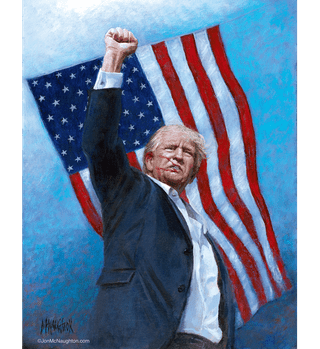 Propaganda image: “Fight Fight Fight” by Jon McNaughton
Propaganda image: “Fight Fight Fight” by Jon McNaughtonTrump threatens and intimidates independent thinkers on a daily basis, including reporters. According to Trump, they’re the “enemy of the people.” He cut funding for independent media and restricted the White House access of established outlets like The New York Times and the Associated Press, instead opening a slot for Trump-friendly influencers. He’s squeezing universities and seizing control of key cultural institutions.
The result? A culture of fear, self-censorship, and ultimately, the destruction of the truth and a shared reality.
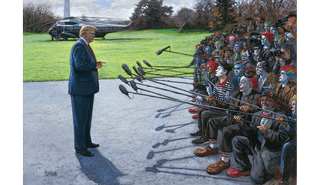 Propaganda image: “You are Fake News!” by Jon McNaughton
Propaganda image: “You are Fake News!” by Jon McNaughtonTrump sees conspiracies against the United States everywhere. He calls immigration an “invasion” that’s “poisoning the blood of our country,” and he started rounding up the country’s estimated 11 million undocumented immigrants.* Nothing’s off-limits: confidential personal information can be used,* and Trump doesn’t want to deploy immigration officers alone, but also other law enforcement officers, as well as officials and “other individuals” who’ve been deputized. Those who don’t leave the country voluntarily will be deported—as Trump put it: “in a place and manner solely of our discretion.”* #MakeAmericaSafeAgain
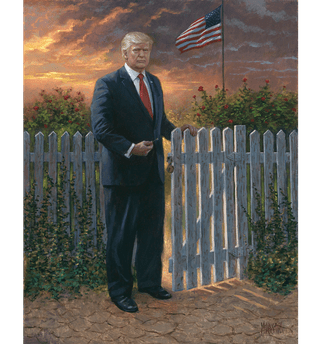 Propaganda image: “Make America Safe” by Jon McNaughton
Propaganda image: “Make America Safe” by Jon McNaughtonAnd abroad, too, Trump is on a collision course to put “America back on top,” driven by a deep-seated belief that a “globalist elite” is intentionally thwarting US interests. It’s an approach that undermines international law and upends world order:* Trump threatens to take territory from countries that were until recently still allies, threatens to leave NATO allies in the lurch if they don’t pay up, paralyzes the International Criminal Court,* and abruptly halts funding for what he calls “a bunch of radical left lunatics” through the “criminal organization” USAID.
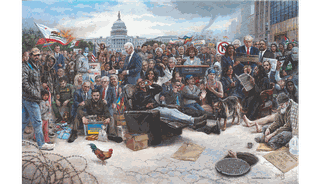 Propaganda image: “It’s a Mad Mad Mad Mad America” by Jon McNaughton
Propaganda image: “It’s a Mad Mad Mad Mad America” by Jon McNaughtonTrump’s foreign policy has one purpose: profit. His trade war is celebrated as “Liberation Day”—and as an investment opportunity for his billionaire buddies.* The real estate potential of a strip of land along the Mediterranean counts for more than all the Palestinian lives snuffed out there.
Trump is setting up a new social order, including hotlines where government employees, schools, and the public can report anyone who threatens that order, be it “woke culture warriors”* or “illegal aliens.” *
That hierarchy is based in part on rigid gender roles. “The Left has tried to erase what it means to be a woman,” the White House claims.* Trump has banned transgender people from the military, sports, and public life, while eliminating words like “gender,” “feminism,” and “equality” from federal websites and government publications. He promises medals and money for women who bear more “American” children.*
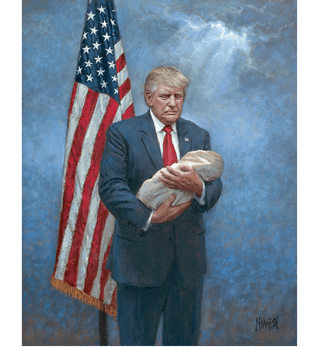 Propaganda image: “Saving a Generation” by Jon McNaughton
Propaganda image: “Saving a Generation” by Jon McNaughtonTrump divides people into who’s needed and who’s not. Coal miners are “real” Americans,* as opposed to the estimated 121,000 federal employees fired by Elon Musk’s ad hoc Department of Government Efficiency, or DOGE,* who fall under the category of “waste, fraud, and abuse”* and could be replaced by chatbots,* according to Musk.
Trump garnered massive support in rural counties with his promise to take care of “climate lunatics,”* stop Biden’s “war on the suburbs,”* and—with the help of the Secret Service if needed—transform big and progressive “pro-crime” cities, like Chicago and Washington, D.C., into MAGA strongholds.*
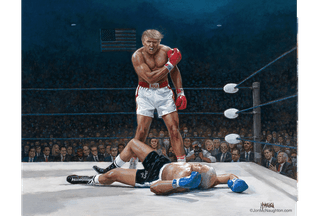 Propaganda image: “The Knockout” by Jon McNaughton
Propaganda image: “The Knockout” by Jon McNaughton Trump is swiftly making the state into a weapon to destroy his enemies. “He who saves his Country does not violate any Law,”* he posted, while sanctioning law firms who take cases against him or his allies, having a judge arrested in her courthouse and indicted for obstruction,* and misusing the law to make immigrants disappear. *
Trump’s Big Lie
And then—straight out of Adolf Hitler’s playbook—there’s Trump’s Big Lie: that the 2020 presidential election was “stolen.”
The warning signs that he was following the fascist playbook were already loud and clear. But new alarm bells went off when Trump, after losing the 2020 election, made a claim so outrageous that it inevitably left its mark: A conspiracy made up of “Left Lunatics, Venezuela and China” had committed election fraud, he said, and stolen the presidency from him. Trump then used the lie to mobilize a motley crew of diehard fans to storm the Capitol and “stop the steal.”
Trump blamed the violence that day on the “corrupt FBI,” “Antifa terrorists,” and “Nancy Pelosi,” who as Speaker of the House was responsible for validating the election results. He dismissed the subsequent probe into his role in the attack as purely an abuse of power on the part of the “deep state.” According to Trump, the Justice Department was weaponized—against him, but primarily against the country: “In the end, they’re not coming after me. They’re coming after you—and I’m just standing in their way.”*
Four years later, on day one of his second term, Trump granted clemency to nearly 1,600 January 6th defendants—whom he dubbed January 6th “hostages.” Among them were leaders of far-right militias, like the Proud Boys. In securing their release for crimes involving violent, antidemocratic acts, he’s also secured for himself a loyal band of armed thugs, who know they have Trump to thank for their freedom and who openly profess to be out for revenge.
And perhaps most importantly: Trump got away with it. He faced next to no consequences and even took revenge on those involved in building a case against him. “That made the Big Lie true, in a fascist sense,” says historian Timothy Snyder. “His de-facto impunity and then de-jure immunity also generated a sense of the untouchable, the heroic.”*
Trump supporters saw evidence of this untouchability—as did Trump himself—in the failed attempt on his life during the 2024 campaign. The bullet narrowly missed, they believed, due to “divine intervention.”* He was now no longer seen as simply a leader, but as someone chosen “by a higher power” to save the country.
But just as it’s a fallacy to ascribe some divine mandate to Trump, it’s also too simplistic to see him as the sole explanation for how things got to this point.
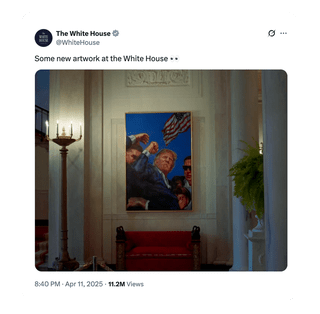
How moderate politicians gave Trump free rein
More moderate politicians of all stripes—from the progressive to the ultra-conservative—could have seen this fascist power grab coming. They failed to do their primary job: safeguarding democracy.
According to political scientists Steven Levitsky and Daniel Ziblatt, authors of the influential work How Democracies Die, it all started with the unfounded belief that democratic elections could keep an anti-democratic candidate out.
Other political lines of defense also went unused: Republicans could have thrown him out of the party due to undemocratic behavior, but instead let themselves be taken in and the party taken over. Congress could have appealed to the Constitution and barred Trump from elections, but didn’t. Republicans and Democrats alike were not prepared to put party interests aside and come together to stop Trump’s rise.*
And so the door is wide open for the next stage of Trump’s fascist power grab.
Since Trump’s return to the White House, he’s issued an endless string of executive orders that seize all the executive power and sideline Congress. *And now he’s taking on the judiciary. The courts can barely keep up with Trump’s torrent of unconstitutional acts—after all, carefully conducted legal proceedings take time. Even so, judges have blocked some 150 executive orders* since Trump was sworn in, whereupon Trump’s team invariably looks for legal loopholes so they can ignore the rulings.*
The result is a constitutional crisis.
The crisis escalated when Trump used an 18th-century wartime act to take a seemingly random group of immigrants and send them—without a fair trial and in violation of a court order—to an appalling prison in El Salvador to disappear. When the US Supreme Court ordered one of the men be returned—Kilmar Abrego Garcia, whom Trump doesn’t deny was arrested in error—Trump said it was out of his hands. He added that he’d like to send more people away, including US citizens. (Only the “really bad ones,” of course.) *

Trump is nearly home free
For Trump, this confrontation with the Supreme Court is a test case. It’s not so much about what he’s legally allowed to do, but whether he gets away with it. It’s about whether he is indeed above the law. “If we can defy this, then we’re home free,” is the thinking, warns Asha Rangappa, senior Yale lecturer and former special agent at the FBI. Then it’s solely up to Trump to determine who’s a “criminal” to be rounded up and what punishment they get.
In a televised interview in May, Trump was asked, “Don’t you need to uphold the Constitution of the United States as president?” Trump replied, “I don’t know.”*
The courts, in any case, have no clear means of enforcing their rulings; law enforcement is in Trump’s hands. One way out of this bind would be for Congress to impeach, but with a Republican majority uncritically aligning with Trump, and a divided Democratic caucus, that doesn’t seem a viable option right now.*
Trump already took to X to express how he would respond to any impeachment attempt: “These Radical Left Lunatics are into the “Impeachment thing” again….Perhaps we should start playing this game on them, and expel Democrats.”*
Trump can do far more, he says, than during his first term as president. “The first time, I had two things to do—run the country and survive; I had all these crooked guys,” he said in April to The Atlantic. “And the second time, I run the country and the world.”*
This all leaves little room for doubt about where this is headed: an unconstitutional third term. After the success of nostalgic MAGA merchandise, Trump is now selling a new hat: Trump 2028 .
The only thing left to keep Trump from running again, according to Levitsky and Ziblatt, is mass popular mobilization. That’s something Carol Rose, one of the directors of America’s largest organization for civil rights and civil liberties, the ACLU, also emphasizes: “It’s an all hands on deck moment. And we can’t afford to say ‘well, we’re gonna leave it to the courts, we’re gonna leave it to the journalists, we’re gonna leave it to the protestors.’” She’s convinced we can only stop Trump if we all come together. “Everyone of us has to be in this fight right now!”
So far, growing numbers of judges, lawyers, journalists, protesters, and universities are standing up and standing firm.* But unfortunately, that kind of resistance comes at considerable personal risk. Trump’s threats of payback, of retribution against his enemies, are now reality.*
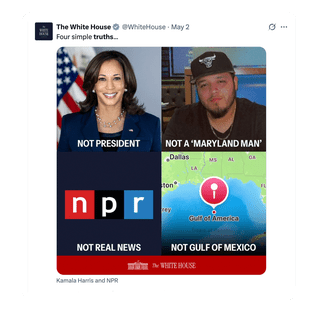
Trumpism: all-American fascism
Over time, fascism has shown the same ten characteristics worldwide. But that doesn’t mean it looks the same everywhere. On the contrary. In addition to clear commonalities, there are striking differences between fascist movements.
Just as Mussolini’s fascism differed from Hitler’s Nazism, Trump sets himself apart from fascists of the 20th century. He’s traded the shrill megaphone for a smartphone, for one thing, to mobilize his supporters online. And for Trump, the state is not only an extension of his ego, but of his business empire, now thought to be worth billions.
Also, fascism isn’t something you export, says Robert Paxton. Fascism draws its legitimacy from “what it considers the most authentic elements of its own community identity.” In other words, each fascist country will have its own form of fascism.
The US gets “Trumpism”—a very American variety.
Trumpism is built upon a foundation of slavery and Jim Crow—the racist laws in place in the early 20th century that robbed Black Americans of their basic constitutional rights. (This form of legalized segregation in turn inspired Hitler’s Nuremberg race laws, which laid the basis for the Holocaust.) Black Americans—along with Native Americans, Latinos, Muslims—are the first to point out that a politics of exclusion and violence in the US is nothing new. It’s been around for centuries.
Trumpism is made up of the socio-economic debris of the American Dream, where a failure to rise out of poverty is seen as a personal failure, and individual success is achieved at the expense of others. It’s assembled from repurposed legislative rubble left over from the War on Terror, and brought to life by tech oligarchs like Elon Musk, whose algorithms cut up the public sphere into bite-sized pieces, then feed them to trolls and conspiracy theorists.
Trumpism could take root and grow because of a noxious yet fertile mix of existential threats, like the depletion of the planet, the climate crisis, the Covid pandemic, and a technology revolution that would make people redundant. The very richest individuals on earth—the ones prepping for what they see as an unavoidable apocalypse (and who therefore want to get rid of democratic regulations)—then hot-housed Trumpism into maturity by throwing the money at it that was needed to regain the White House. *
These deep American roots mean Trumpism has a “much more solid social base,” says Paxton. That’s something “neither Hitler nor Mussolini would have had.”* It’s an insight that should make every comparison with Hitler’s Nazism acutely unnecessary.
Hitler has been relegated to his own horrific place in history. Fascism, as yet, has not.
What if Trump wins his power struggle with judges and manages to squash the resistance growing among the public? Where does this end?
According to Paxton, a fascist regime is by definition unstable: “Fascist regimes could not settle down into a comfortable enjoyment of power. The charismatic leader had made dramatic promises.” He must relentlessly continue saving his people from “the enemy.” If he stops doing what he promised, the fascist movement comes to a halt and resolves into an autocratic regime.
If a leader continues down the fascist road, then he waltzes—unhindered by democratic institutions or practices—right into the final stage of the fascist process: radicalization. Here, he’ll display an “ever-mounting spiral of more daring challenges,” and the fanatics—or in this case, Trump’s “solid social base”—will be unleashed.
That kind of radicalization isn’t sustainable in the long term. Not for anyone. And so, unfettered fascism does at some point end—with complete self-destruction and a society in ruins.
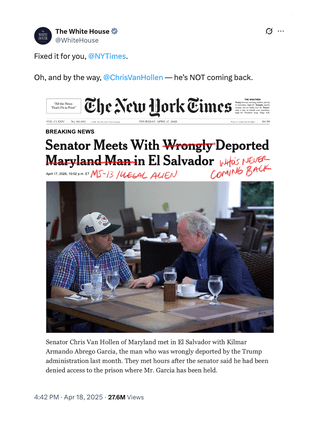
This is also Europe’s problem
Europeans are clearly not immune to the pull of fascism. Not in the past, and not now.
While Trump may be the face of fascism today, there’s a slew of far-right European politicians who are moving in lockstep with him. What does that mean for Europe?
This past February, a number of Europe’s far-right politicians gathered in Madrid under the banner of “Make Europe Great Again” (hardly original, but someone must have thought that covered it). Together, they rang in the start of the new Trump era—and their own. *
The leader of the Dutch far-right Freedom Party, Geert Wilders, said on stage that Trump II is nothing less than a political earthquake, for Europe as well. “He brings a message of hope,” he proclaimed.
At the same rally, Hungary’s prime minister Viktor Orbán likewise cheered Trump’s reelection and what it means for the far-right worldwide. “Trump’s tornado has changed the world in two weeks,” he said. “Yesterday, we were the heretics; today, we’re mainstream.”
It’s undeniable that the far-right in Europe has gained considerable influence in the past few years, by digging up hate that many thought was dead and buried.
This strategy worked for a number of similar politicians, like Alice Weidel, leader of Germany’s AfD party, which was recently deemed extremist and can count on the open support of Trump and his associates.* It worked for the Italian prime minister Giorgia Meloni, who has joined forces with Trump “to Make the West Great Again.”* And it worked for Marine Le Pen, leader of the French far-right National Rally party, who also calls her criminal conviction “a witch hunt.”*
All these politicians know—as does Trump—how to mobilize sizable blocs of voters by taking on “wokeism” and “gender ideology,” “criminal aliens” and “liberal fascists,” the “parasitic press” and the European Union’s “institutionalized weakness.”
Normalizing fascism in Europe
For the first time in modern history, far-right parties in some European countries have won a larger share of the votes than the Conservatives and the Social Democrats.
In seven countries, including the Netherlands and Italy, the far right has a dominant role in the current administration. In others, like France and Germany, support for the far-right is on the rise. In Italy, Bulgaria, Slovakia, Croatia, and Romania, far-right parties have taken measures that actively undermine the rule of law and limit freedom of the press.* Hungary is now beyond that stage and sliding towards dictatorship.
These same parties also booked historic wins in the past year in the European Parliament. They now hold over 25% of the seats, clearly making their mark on EU policy, often with the help of center-right parties who are taking on their positions and normalizing them. *
In short: The European continent is seeing a strong push from the far right.
And yet there’s reason to believe things won’t get out of hand as quickly as in the United States. Center-left and center-right parties hope that Trump’s extreme approach, which led to electoral losses for the far-right elsewhere, like in Canada and Australia, will serve as a deterrent in Europe, too. There’s just one thing: that doesn’t seem to be the case in practice. In recent elections in Germany, the UK, Romania, and Portugal, the far-right gained ground. *
What may be more important is that Europe’s multi-party systems provide stronger lines of defense. In theory, anyway. Due to the culture of cooperation and compromise that such systems entail, and the fragmented political landscape with so many different parties, the far-right generally has to forge a coalition with more moderate parties if they’re to rule. That makes it harder, though by no means impossible, to undermine the rule of law and upend the system. Hitler only had a third of the votes and came to power by forming a right-wing ruling coalition—with disastrous results.
No democratic system is fully protected against powers that want to destroy it. But a multi-party system does give traditional right-wing parties a trump card that Americans, with their two-party system, didn’t have. By ruling out working with far-right parties, traditional right-wing parties can keep the far-right contained, because voters see a vote for the far-right as a vote thrown away, a vote for a party that cannot win, cannot rule.
But that only works if traditional parties make use of this option and hold the line. The opposite is now the case. Right-wing parties, with a few exceptions, show an increased willingness to take on far-right positions* and a greater openness to governing with the far-right—which may well be another key reason for the far-right’s recent rise.
The textbook example of this political dynamic is found in the Netherlands. After the conservative People’s Party for Freedom and Democracy (in Dutch, the VVD) adopted the anti-immigration stance of the far-right Freedom Party (the PVV) in 2023 and didn’t rule out forming a coalition together, Geert Wilders and his far-right PVV scored a historic win in the elections that year, garnering more votes than any other party in the country.
The consequences are alarming: across Europe, far-right rhetoric, methods, and politics are slowly but surely starting to seem normal.
Our wakeup call
Let that be our wakeup call. Treating these far-right groups as regular political players is a catastrophic miscalculation—one that can mean the end of democracy as we know it.
Now that the US government considers it fair game to attack international democracy and the rule of law, it’s up to the rest of us to protect freedom.
That starts with the clear-eyed recognition that freedom is fragile. Because history shows: once people take their political freedom for granted, they’re at risk of losing it.
Those who comfort themselves and others with the idea that “things won’t move that quickly here,” are complicit in speeding things up. And if that still sounds alarmist? That means it’s not yet too late.
This article was originally published in Dutch on May 22, 2025. English translation by Erica Moore
.png)



